The document discusses the development of a contextualized software configuration management (SCM) model tailored for small and medium software development firms, particularly in developing countries like Kenya. It identifies the shortcomings of existing models that are oriented towards larger enterprises and proposes an improved approach that incorporates local industry context and challenges. The study also emphasizes the importance of software configuration management in ensuring quality in software products and recommends further development of the proposed model into a commercial software tool.

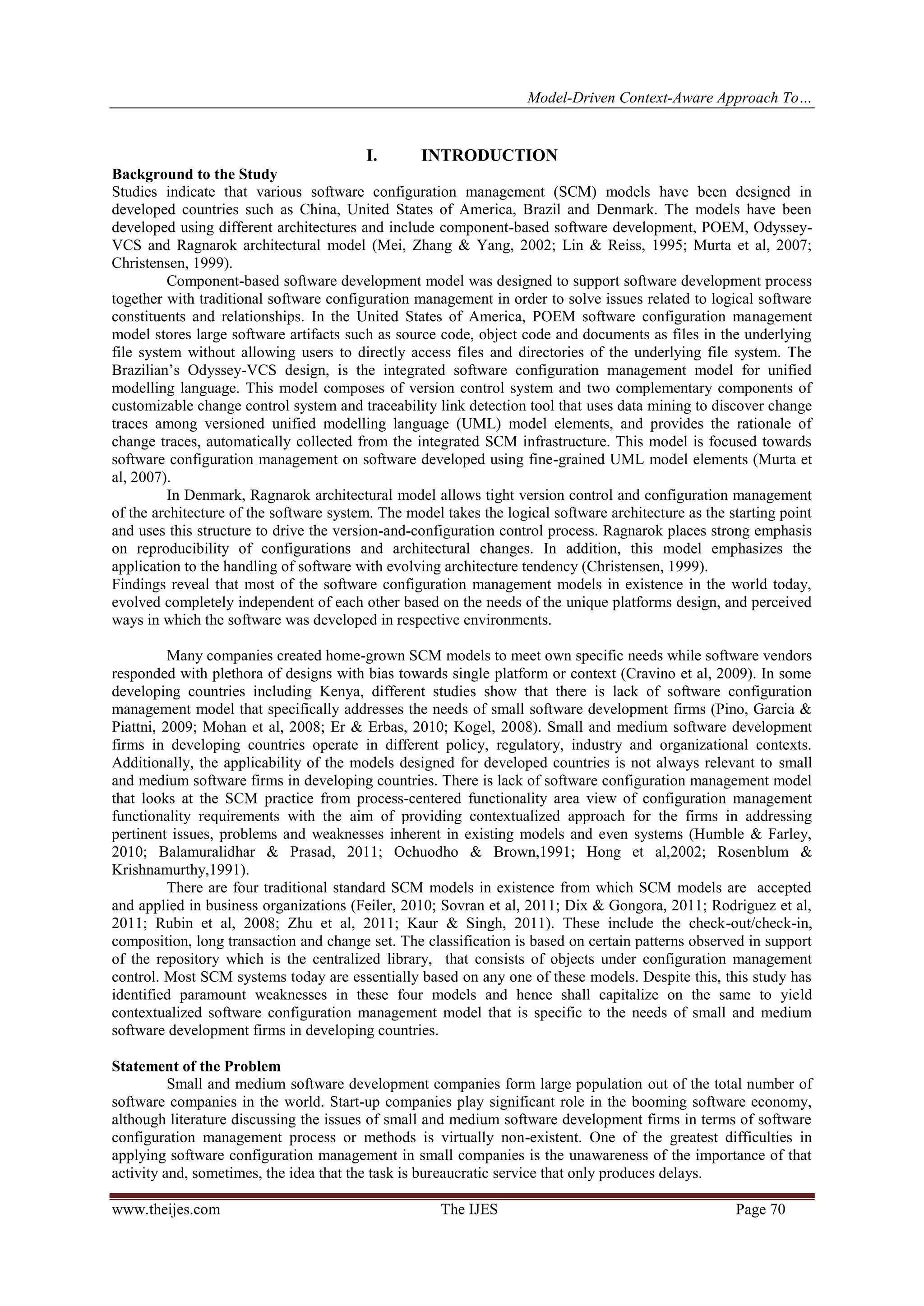
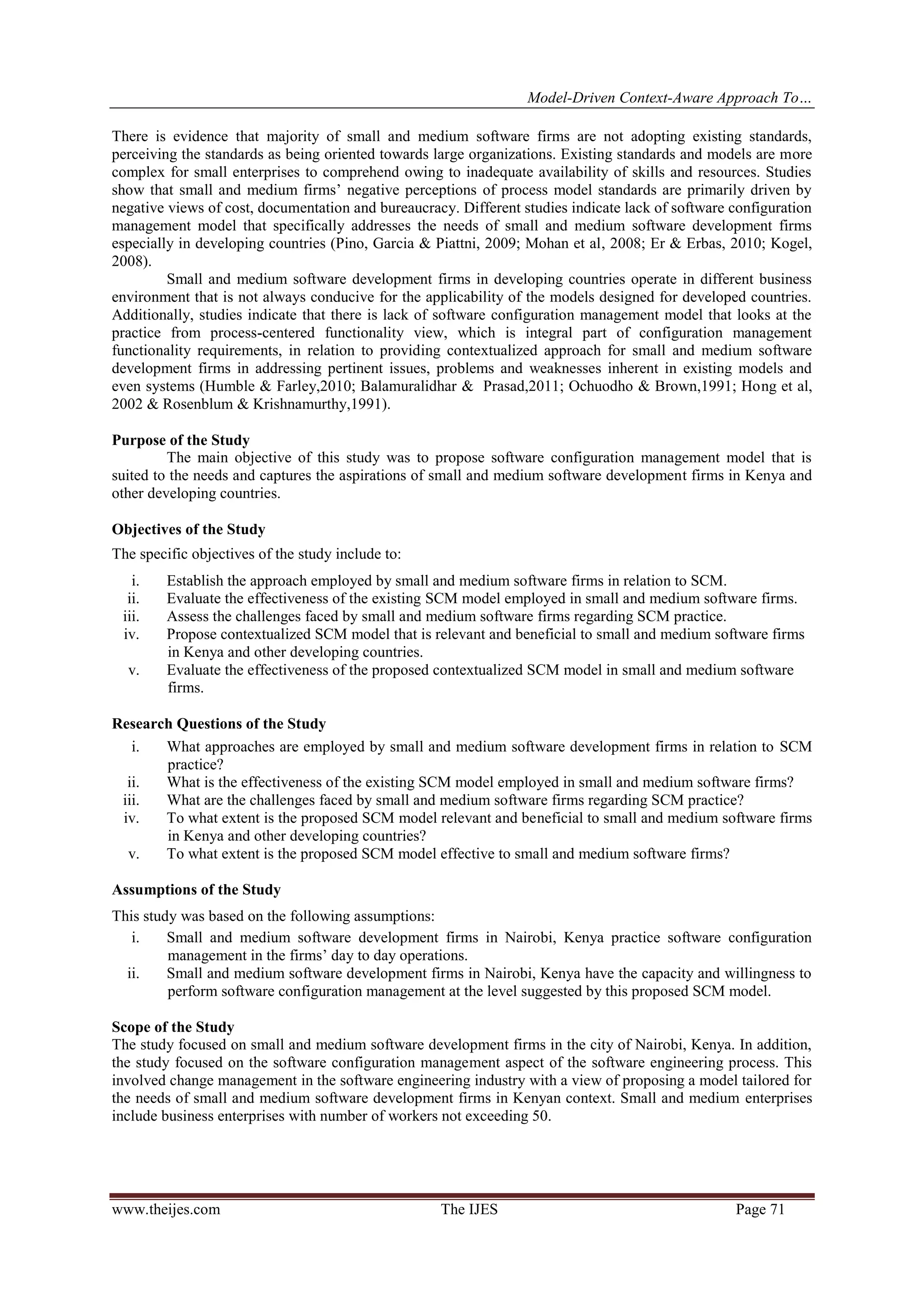
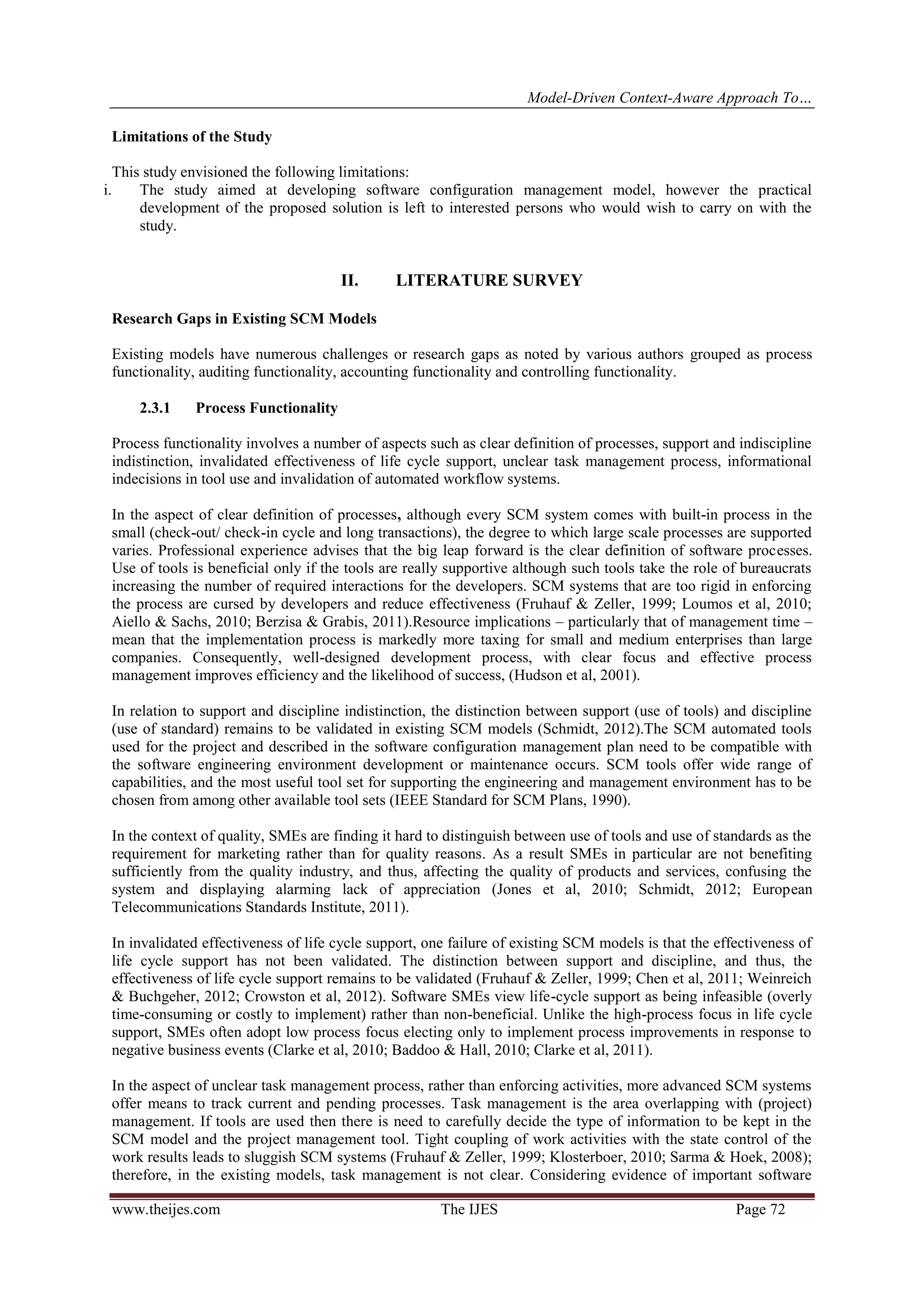
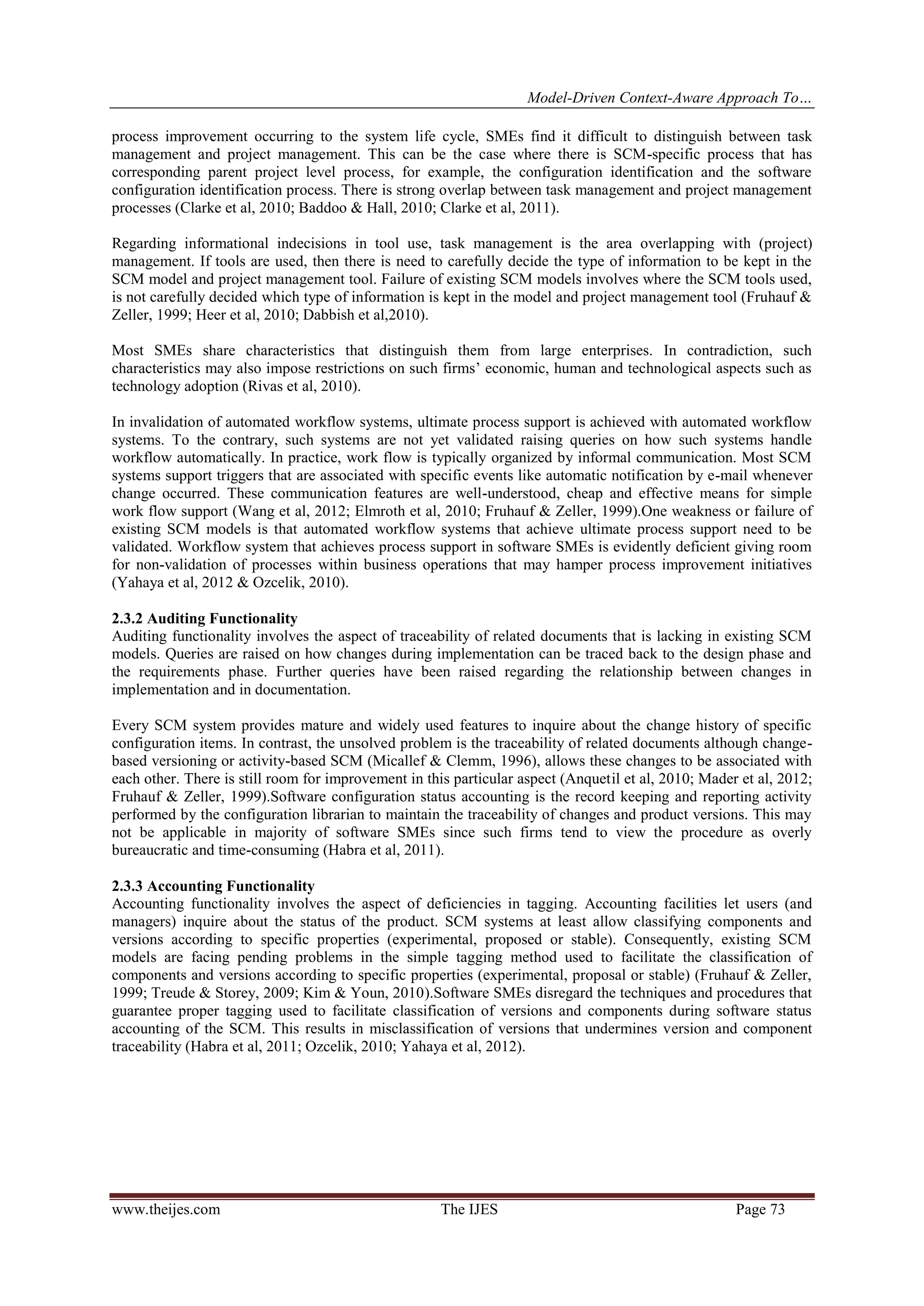
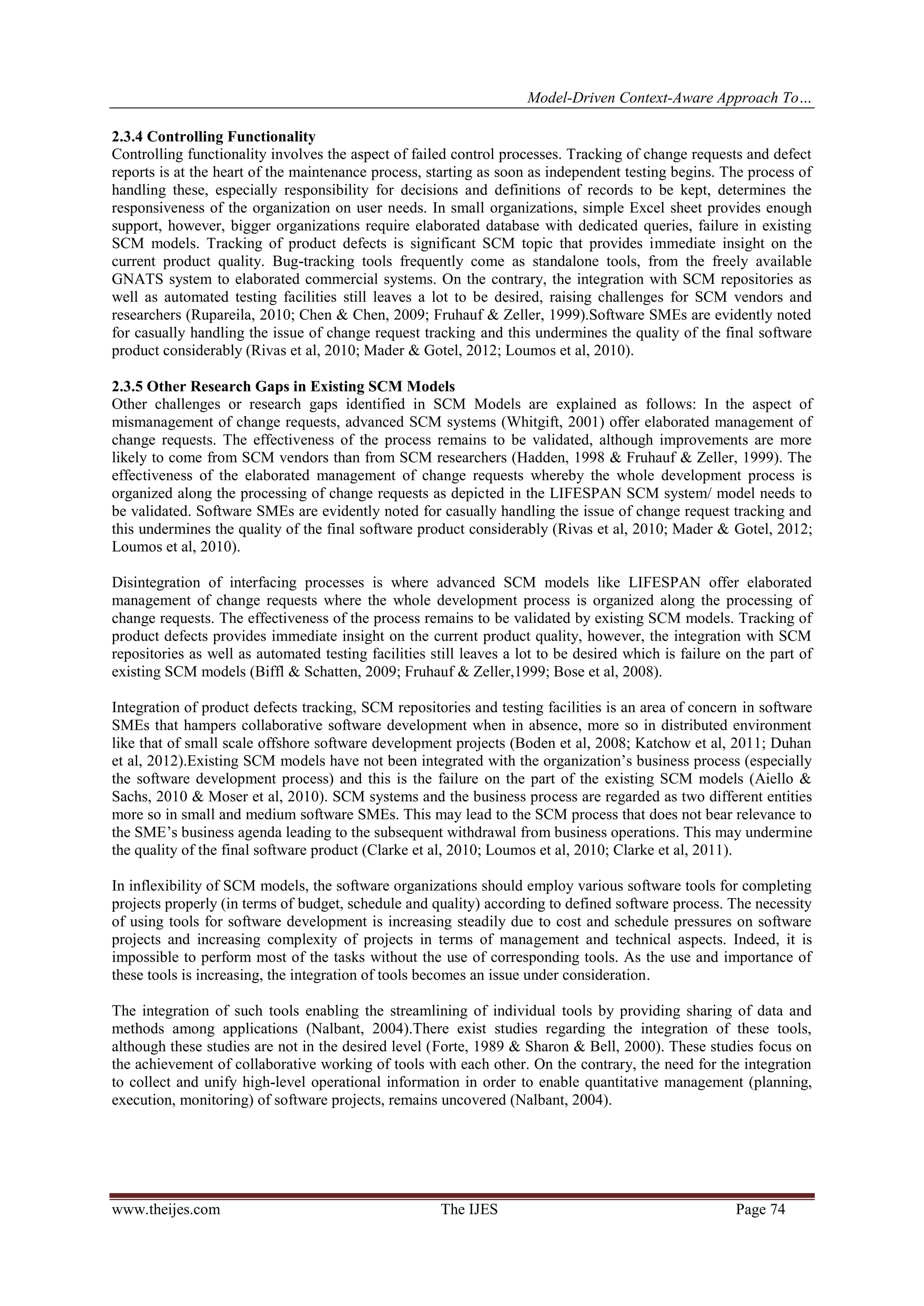
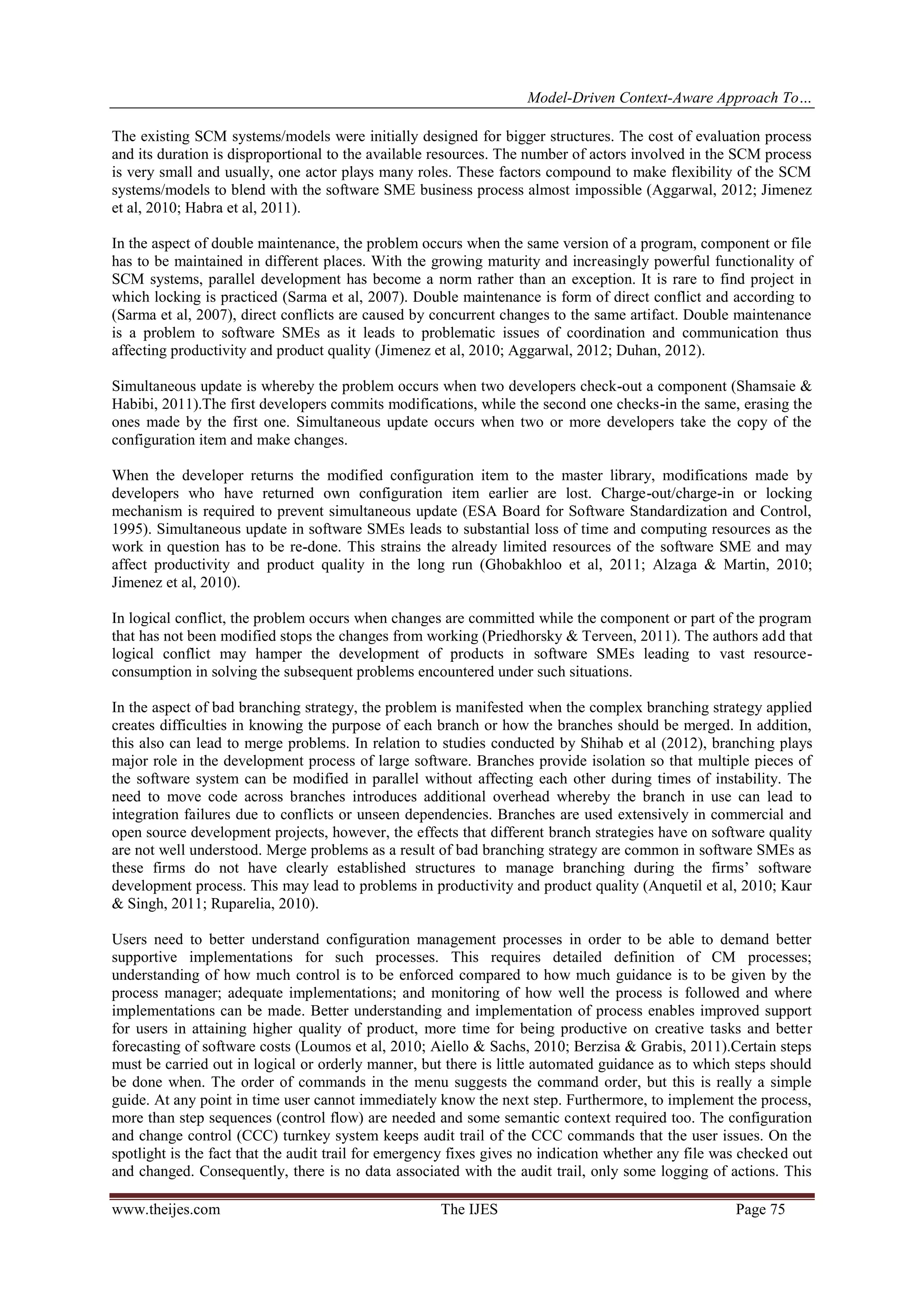
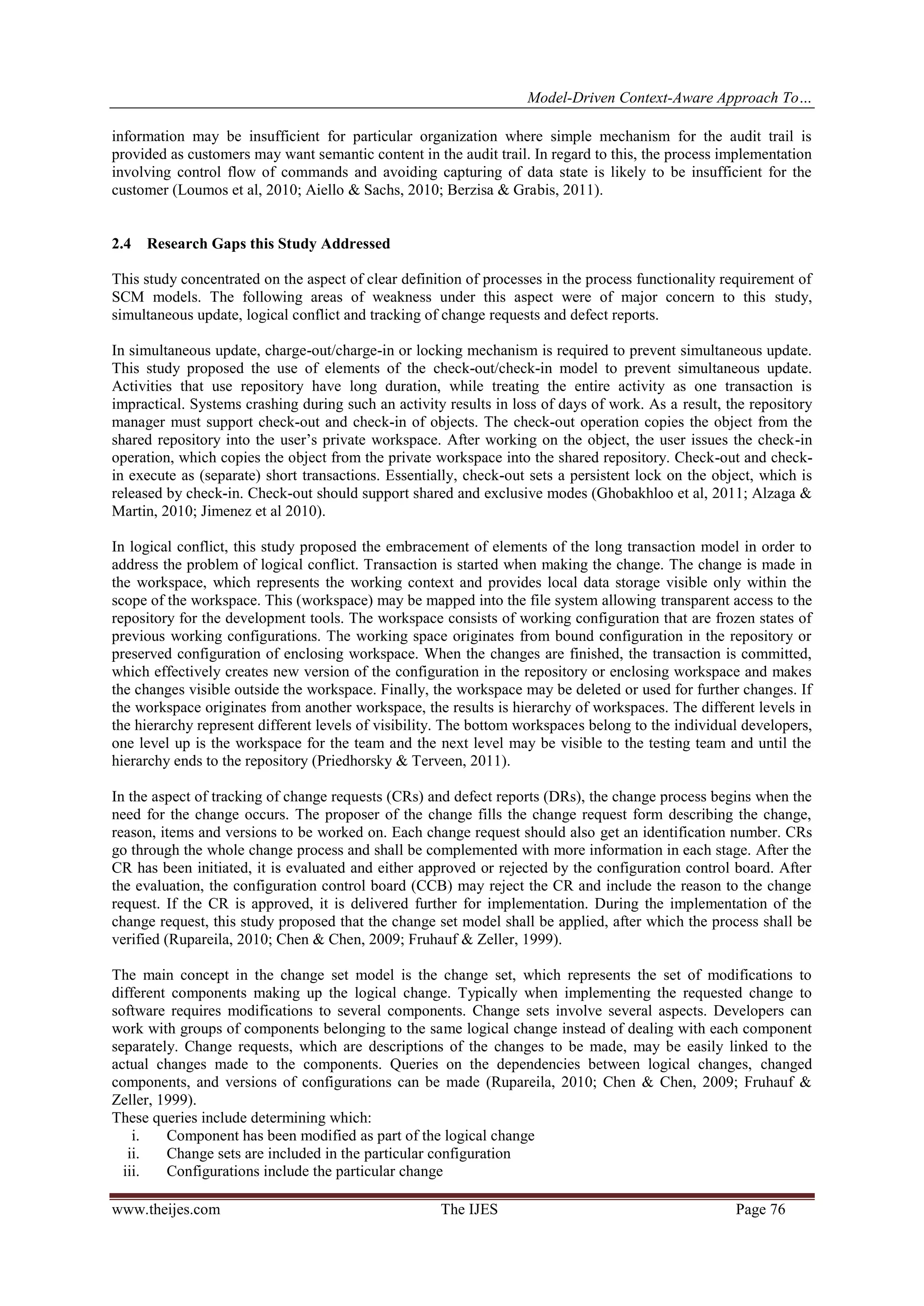
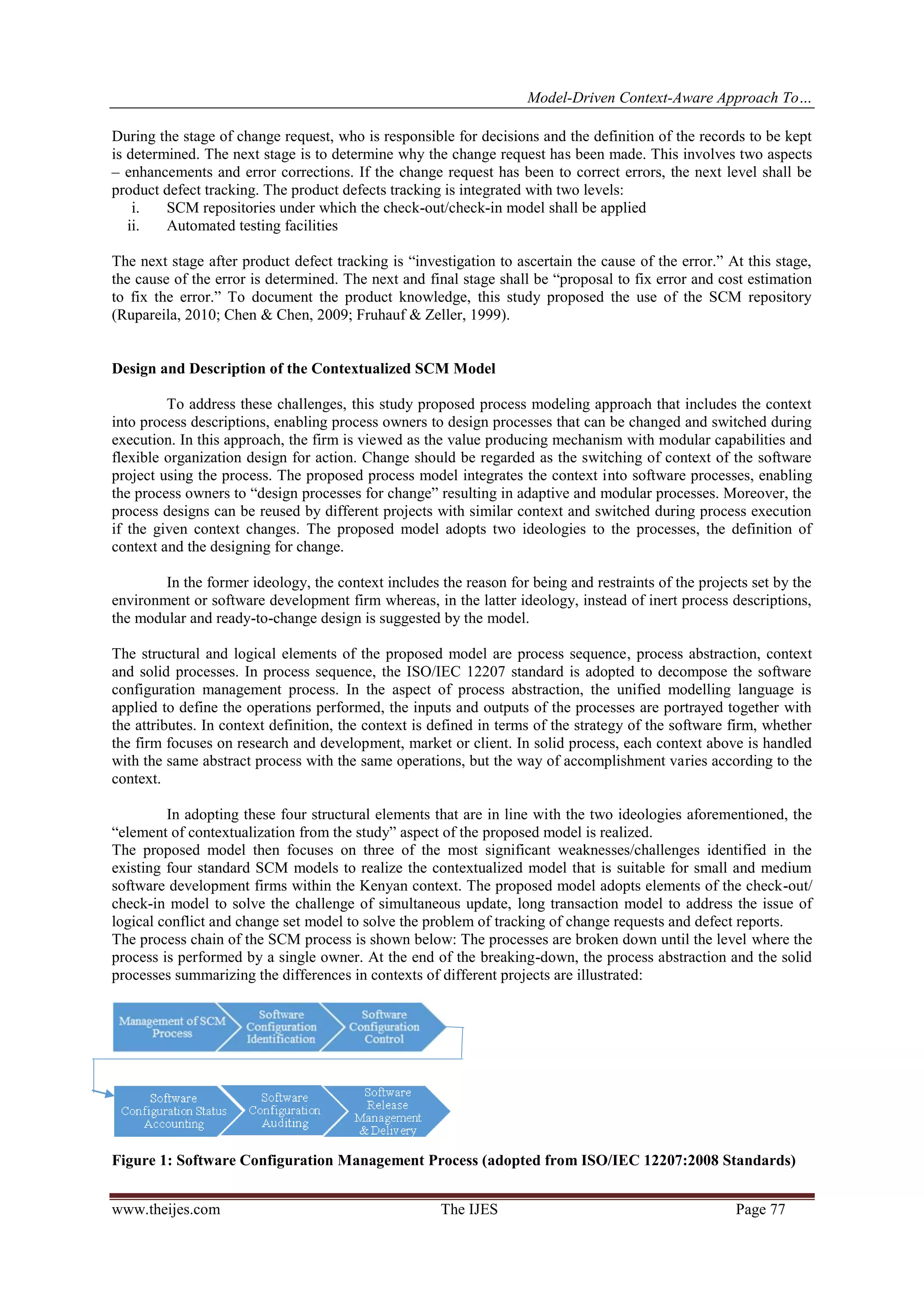
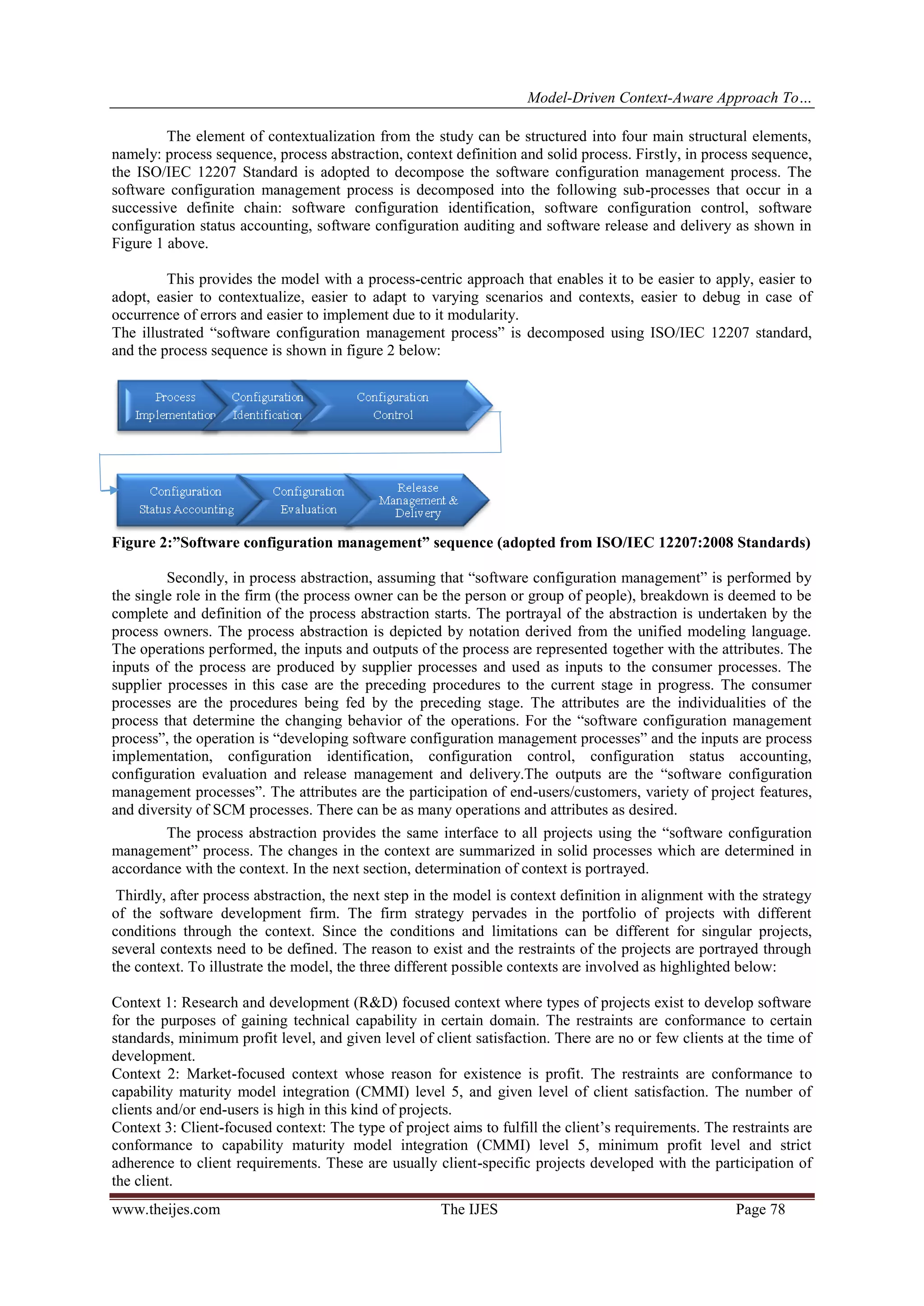
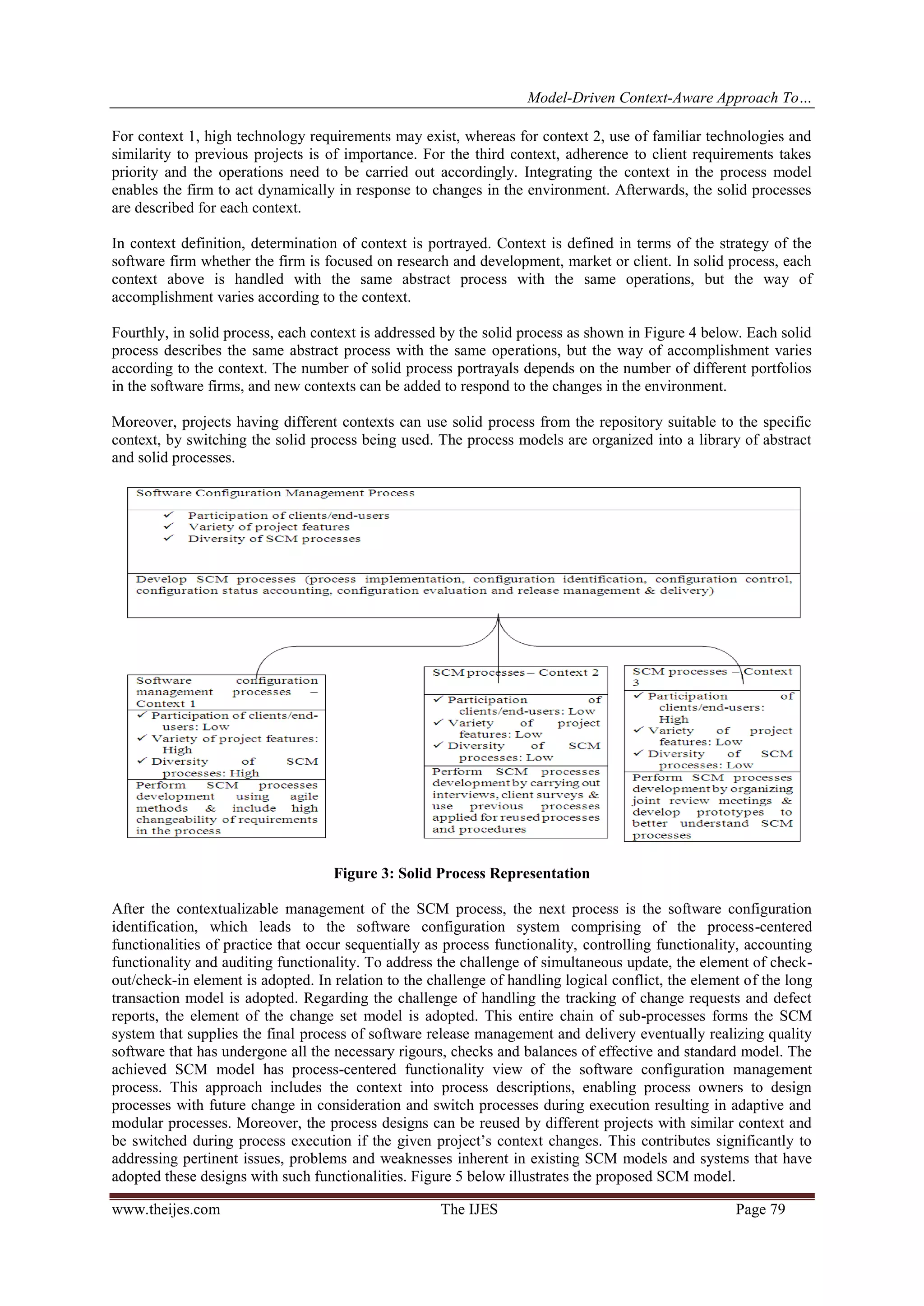
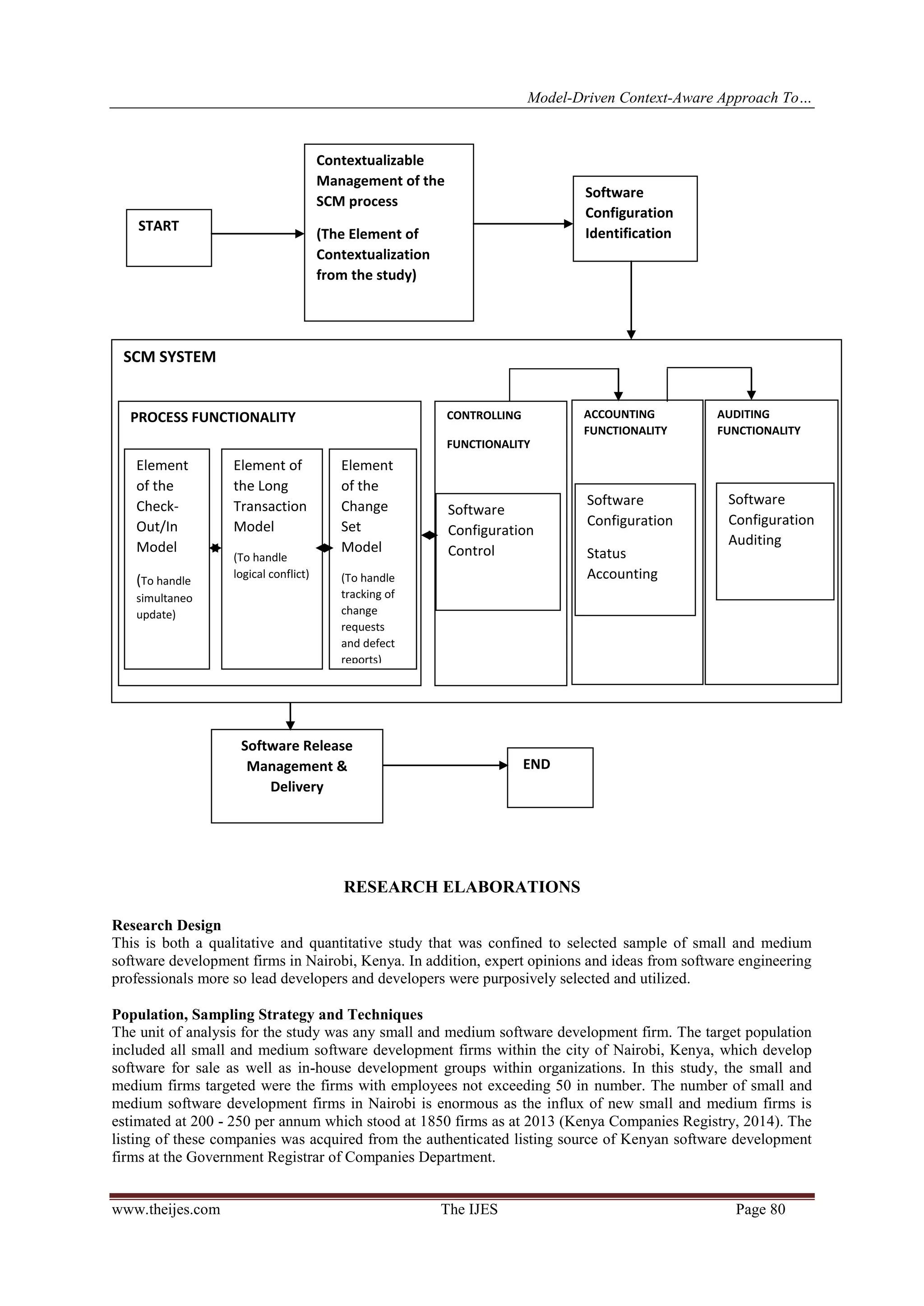
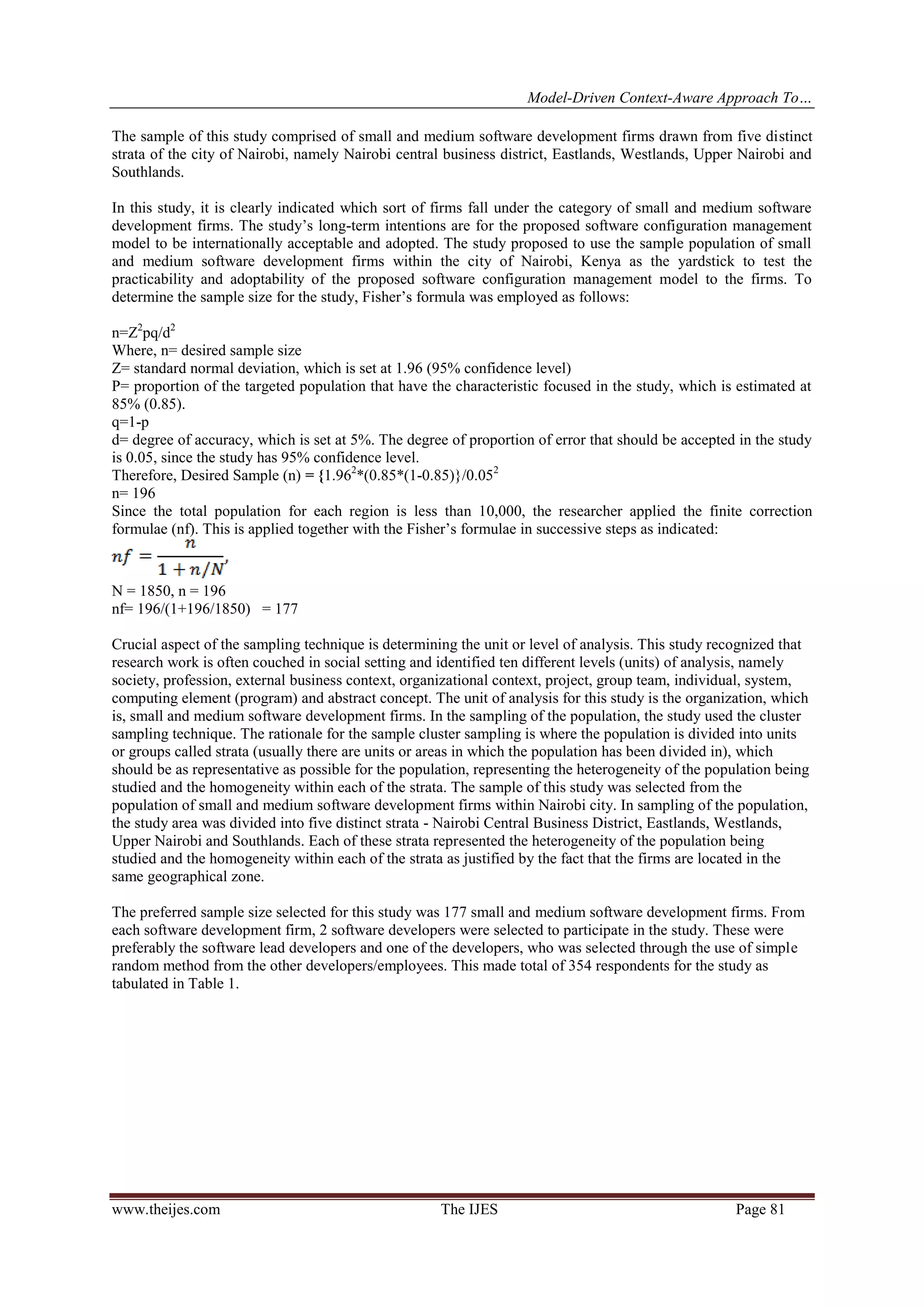
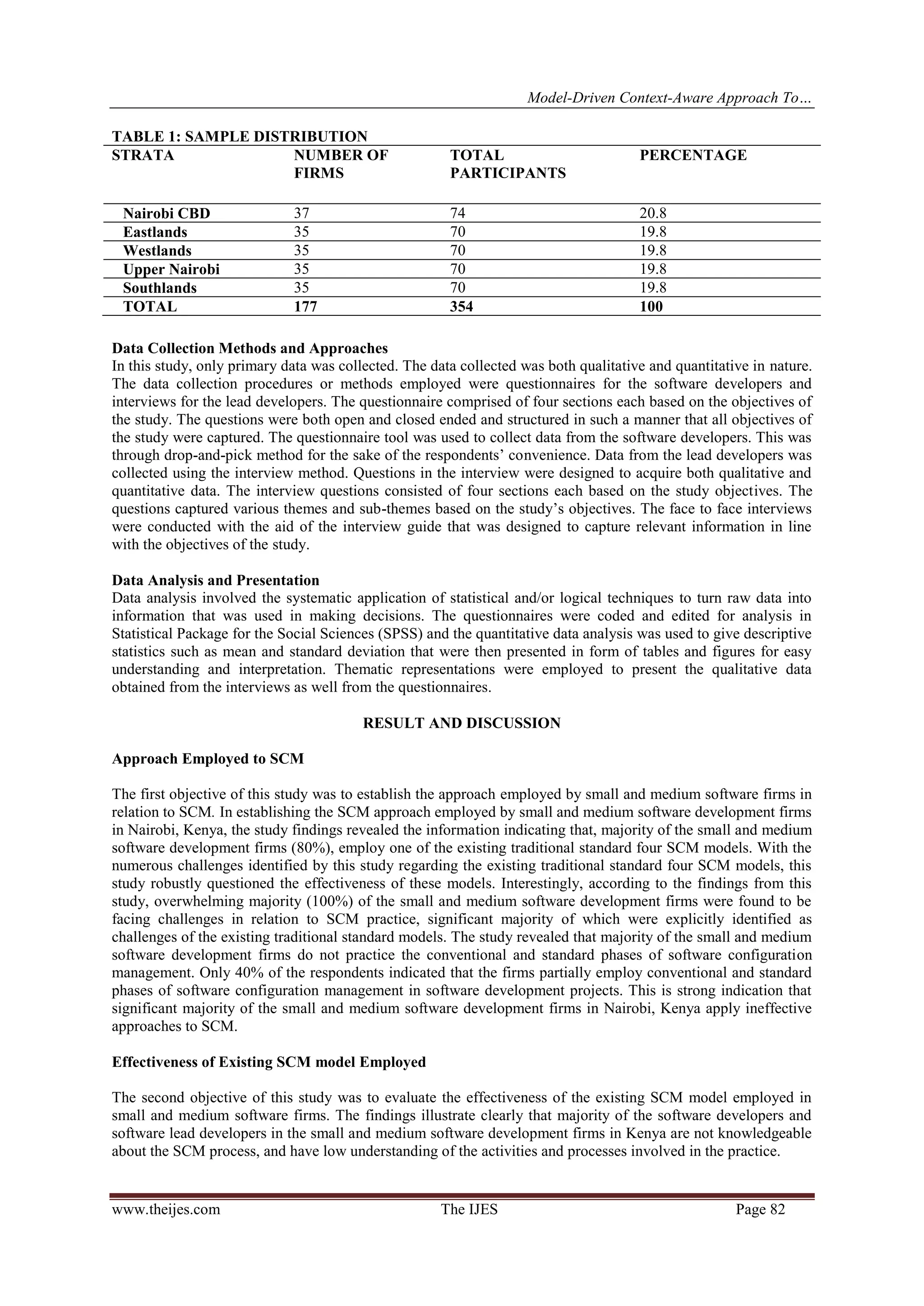
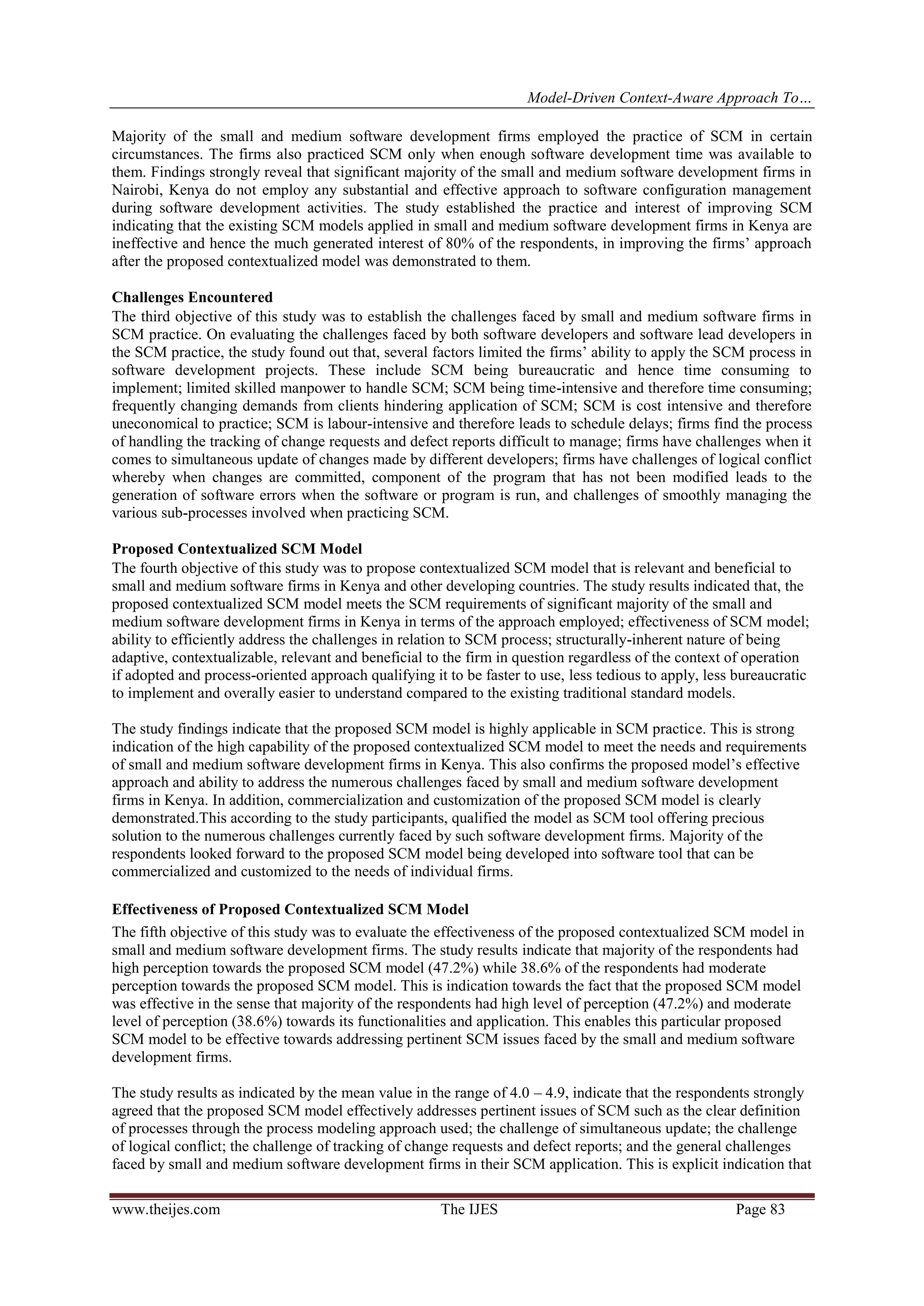
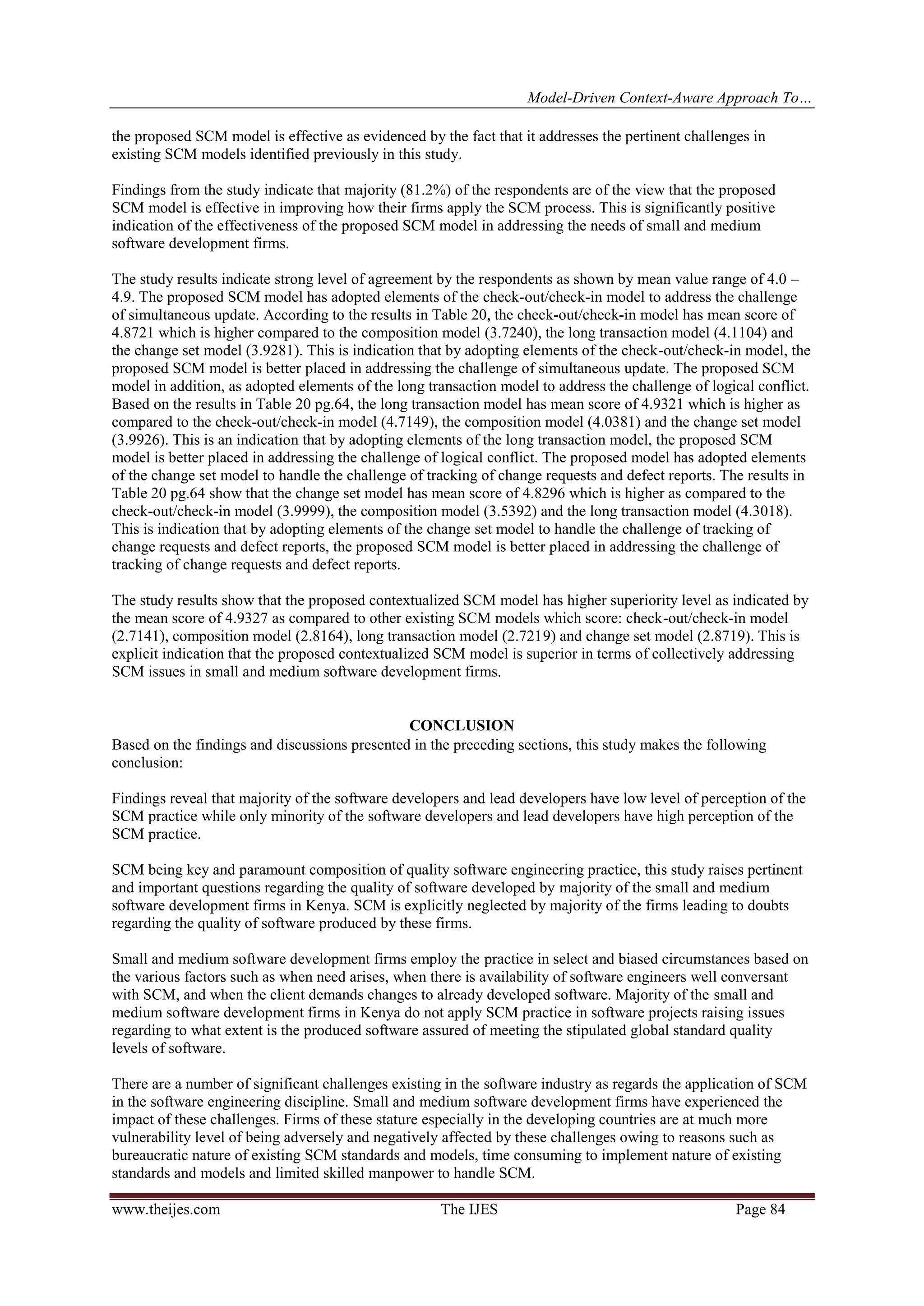


![Model-Driven Context-Aware Approach To…
www.theijes.com The IJES Page 87
Figure 8: Proposed Contextualized SCM Model for Small and Medium Software Development Firms
REFERENCES
[1]. Aggarwal, H. (2012). Identification of Effective Key Processes in Software Process Improvement Models for SMEs. International
Journal of Research in Engineering & Applied Sciences, 2(2):
[2]. Aiello, R., and Sachs, L. (2010). Configuration Management Best Practices: Practical Methods that work in the Real World, 1st
edition. Addisson-Wesley Professional.
[3]. Alzaga, A., and Martin, J. (2010). A Design Process Model to Support Concurrent Project Development in Networks of SMEs.
Foundation TEKNIKER, Eibar, Spain.
[4]. Anquetil, N., Kulesza, U., Mitschke, R., Moreira, A., Royer, J., Rummler, A., and Sousa, A. (2010). A model-driven traceability
framework for software product lines. New York: Springer-Verlag.
END
Software Release
Management &
Delivery
SCM SYSTEM
ACCOUNTING
FUNCTIONALITY
AUDITING
FUNCTIONALITY
Software
Configuration
Status
Accounting
Accounting
Software
Configuration
Auditing
PROCESS FUNCTIONALITY
Element
of the
Check-
Out/In
Model
(To handle
simultaneo
uupdate)
Element of
the Long
Transaction
Model
(To handle
logical conflict)
Element
of the
Change
Set
Model
(To handle
tracking of
change
requests
and defect
reports)
CONTROLLING
FUNCTIONALITY
Software
Configuration
Control
START
Software
Configuration
Identification
Process Sequence
Process Abstract
Context Definition
Solid Process](https://image.slidesharecdn.com/g423069089-150310023401-conversion-gate01/75/Model-Driven-Context-Aware-Approach-to-Software-Configuration-Management-A-Focus-on-Small-and-Medium-Software-Development-Firms-19-2048.jpg)
![Model-Driven Context-Aware Approach To…
www.theijes.com The IJES Page 88
[5]. Baddoo, N., and Hall, T. (2010). De-Motivators for Software Process Improvement: An Analysis of Practitioners’ views. Journal of
Systems and Software, 66(1), 23-33.
[6]. Balamuralidhar, P., and Prasad, R. (2011). Self-configuration and Optimization for cognitive networked devices. Wireless Personal
Communications: An International Journal, 59(3), Kluwer Academic Publishers.
[7]. Berzisa, S.,and Grabis, J. (2011). Combining project requirements and knowledge in configuration of project management information
systems. Profes ’11: Proceedings of the 12th
International Conference on product focused software development and process
improvement. ACM.
[8]. Biffl, S., and Schatten, A. (2009). A platform for service-oriented integration of software engineering environments. Proceedings of
the 2009 Conference on New Trends in Software Methodologies, Tools and Techniques. IOS Press.
[9]. Boas, G.V., Cavalcanti, A.R., and Amaral, M.P. (2010). An Approach to implement Software Process Improvement in Small and Mid-
Sized Organizations. Proceedings of the 2010 Seventh International Conference on the Quality of Information and Communications
Technology, IEEE Computer Society.
[10]. Boden, A., Muller, C., and Nett, B. (2011). Conducting a Business Ethnography in Global Software Development Projects of Small
German Enterprises. Information and Software Technology, 53(9), Butterworth-Heinemann.
[11]. Bose, I., Pal, R., and Ye, A. (2008). ERP and SCM systems integration: The case of a valve manufacturer in China. Information and
Management, 45(4). Elsevier Science Publishers.
[12]. B.V.Capability Maturity Model Integration (CMMI) Overview. Carnegie Mellon University: Software Engineering Institute.
[13]. Chen, C.Y., and Chen, P.C. (2009). A Holistic approach to managing software change impact. Journal of Systems and Software,
82(12). Elsevier Science Inc.
[14]. Chen, N., Hoi, S., & Xiao, X. (2011). Software process evaluation: A machine learning approach. ASE ’11: Proceedings of the 2011
26th
IEEE/ACM International Conference on Automated Software Engineering. IEEE Computer Society.
[15]. Christensen, H.B. (1999). The Ragnarok Architectural Software Configuration Management Model. Proceedings of the 32nd
Hawaii
International Conference on System Sciences.
[16]. Clarke, P., O’Connor, R. (2011). An Approach to evaluating Software Process Adaptation. In: Proceedings of the 11th
International
Conference on Software Process Improvement and Capability Determination, pp.28-41. Springer-Verlag, Hiedelberg/Berlin,
Germany.
[17]. Clarke, P., O’Connor, R., Yilmaz, M. (2010). A hierarchy of SPI activities for software SMEs: results from ISO/IEC 12207-based SPI
assessments. Dublin City University, Ireland.
[18]. Cravino, P., Lawrence, D., Lopez, A., Onorato, B., and Shen, Z. (2009).Enterprise Software Configuration Management Solutions for
Distributed and System Z. International Business Machines (IBM).
[19]. Crowston, K., Wei, K., Howison, J., and Wiggins, A. (2012). Free/Libre open-source software development: What we know and what
we do not know. Computing Surveys (CSUR), 4(2). ACM.
[20]. Dabbish, L.A., Wagstrom, P.,Sarma,A., and Herbsleb, J.D. (2010). Coordination in innovative design and engineering: observations
from a lunar robotics project. Group ’10: Proceedings of the16th
ACM international conference on supporting group work. ACM.
[21]. Dix, A., & Gongora, L. (2011). Externalisation and Design. DESIRE ’11: Proceedings ofthe second conference on creativity and
innovation in design. ACM.
[22]. Duhan, S., Levy, M., and Powell, P. (2012). Is Strategy in SMEs using Organizational Capabilities: The CPX Framework. United
Kingdom.
[23]. Elmroth, E., Hernandez, F., and Tordsson, J. (2010). Three fundamental dimensions of scientific workflow interoperability: model of
computation, language, and execution environment. Future Generation Computer Systems, 26(2). Elsevier Science Publishers B.V.
[24]. Er, N.P., and Erbas, C. (2010). Aligning software configuration management with governance structures. SDC ’10: Proceedings of the
2010 ICSE Workshop on Software Development Governance, ACM.
[25]. European Telecommunications Standards Institute. (2011). Small and Medium-sized Enterprises (SMEs) in Standardization;
Understanding and Supporting SME involvement in ICT standardization. Sophia AntipolisCedex- France.
[26]. Feiler, P.H. (2010). Configuration Management models in commercial Environments.Tech Rept. CMU/SEI-91-TR-7, ADA 235782,
Software Engineering Institute, Carnegie Mellon University.
[27]. Forte, G. (1989). In search of the Integrated Environment. CASE Outlook. Retrieved on July19, 2012, from journals.tubitak.gov.tr.
[28]. Fruhauf, K., and Zeller, A. (1999).Software Configuration Management: State of the Art, State of the Practice.
[29]. Ghobakhloo, M., Sabouri, M.S., Hong, T.S., and Zulkifli, N. (2011). Information Technology Adoption in Small and Medium-Sized
Enterprises; An Appraisal of Two Decades Literature. Interdisciplinary Journal of Research in Business, 1(7), Pp.53-80.
[30]. Habra, N., Niyitugabira, E., Lamblin, A., and Renault, A. (2011). Software Process Improvement in Small Organizations using
Gradual Evaluation Schema. University of Namur.
[31]. Hadden, R. (1998). “Key Practices to the CMM: Inappropriate for Small Projects Panel”. In: Proceedings of the Software Engineering
Process Group Conference, Chicago.
[32]. Heer, T., Heller, M., Westfechtel, B., and Worzberger, R. (2010). Tool Support for dynamic development processes. Springer-Verlag.
[33]. Hong, M., Zhang, L.,and Fuqing, Y. (2002). A Component-based software configuration management model and its supporting
system. Journal of Computer Science and Technology, 17(4). Institute of Computing Technology.
[34]. Hudson, M., Smart, A., and Bourne, M. (2001). Theory and Practice in SME performance measurement systems. International Journal
of Operations & Product Management, 21(8), pp. 1096-1115.
[35]. Humble, J., and Farley, D. (2010). Continuous Delivery: Reliable Software Releases through Build, Test, and Deployment Automation,
1st
edition. Addison-Wesley Professional.
[36]. Jimenez, M., Vizcaino, A., and Piattini, M. (2010). Improving Distributed Software Development in Small and Medium Enterprises.
The Open Software Engineering Journal, 4, pp.26-37.
[37]. Jones, R., Thomas, P., and Thomas, K. (2010). Quality Management Tools and Techniques: Profiling SME use & Customer
Expectations. The International Journal for Quality and Standards.
[38]. Katchow, R., Weerd, I., Brinkkemper, S., and Rooswinkel, A. (2011). Software Product Manager: A Mechanism to manage Software
Products in Small and Medium ISVs. Utrecht University, The Netherlands.
[39]. Kaur, P., and Singh, H. (2011). A model for versioning control mechanism in component-Based systems. SIGSOFT Software
Engineering Notes, 36(5). ACM.
[40]. Kim, D., and Youn, C. (2010). Traceability Enhancement Technique through the integration of software configuration management
and individual working environment. SSIRI ’10: Proceedings of the 2010 Fourth International Conference on secure software
integration and reliability improvement. IEEE Computer Society.
[41]. Klosterboer, L. (2010). Implementing ITIL Configuration Management, 2nd
edition. IBM Press.](https://image.slidesharecdn.com/g423069089-150310023401-conversion-gate01/75/Model-Driven-Context-Aware-Approach-to-Software-Configuration-Management-A-Focus-on-Small-and-Medium-Software-Development-Firms-20-2048.jpg)
![Model-Driven Context-Aware Approach To…
www.theijes.com The IJES Page 89
[42]. Kogel, M. (2008). Towards Software Configuration Management for Unified Models. CVSM’ 08: Proceedings of the 2008
international workshop on comparison and versioning of software models, ACM.
[43]. Lin, Y.J., and Reiss, S.P. (1995). Configuration Management in terms of modules. Proceedings of the 5th
International Workshop on
Software Configuration Management, pp.17-26.
[44]. Loumos, V., Christonakis, G., Mpardis, G., and Tziova, P. (2010). Change Management and Quality of Service through Business
Process Modelling: The N-VIS, a Public Sector Project. ITNG ’10: Proceedings of the 2010 Seventh International Conference on
Information Technology: New Generation. IEEE Computer Society.
[45]. Mader, P., and Gotel, O. (2012). Controversy Corner: Towards automated traceability maintenance. Journal of Systems and Software,
85(10). Elsevier Science Inc.
[46]. Mei, H., Zhang, L., and Yang, F. (2002). A Software Configuration Management Model for Supporting Component-Based Software
Development. Software Engineering Notes, 26(2), 53.
[47]. Micallef, J., and Clemm, G.M. (1996). The Asgard System: Activity-Based Configuration Management. In SCM-6 Workshop, March
1996 (pp.175-187). Berlin, Germany: Springer Verlag LNCS1167.
[48]. Mohan, K., Xu, P., Cao, L., and Ramesh, B. (2008). Improving change management in software development: Integrating traceability
and software configuration management. Decision Support systems, 45(4).
[49]. Moser, T., Mordinyi, R., and Biffl, S. (2010). An ontology-based methodology for supporting knowledge-intensive multi-discipline
engineering processes. ODiSE ’10: Ontology-Driven Software Engineering. ACM.
[50]. Murta, L., Dantas, C., Oliveira, H., Lopes, L., and Werner, C. (2007). An Integrated Software Configuration Management
Infrastructure for UML models. Elsevier, Science of Computer Programming, 65(3).
[51]. Nalbant, S. (2004). An Information System for Streamlining Software Development process. Turk J ElecEngin, 12(2). Retrieved on
July 19, 2012, from journals.tubitak.gov.tr.
[52]. Ochuodho, S.J., and Brown, A.W. (1991). A Process-oriented version and configuration management model for communications
software. SCM ’91: Proceedings of the 3rd
international workshop on software configuration management. ACM.
[53]. Ozcelik,Y. (2010). Do business process re-engineering projects payoff? Evidence from the United States. International Journal of
Project Management, 28, pp.7-13.
[54]. Pino, F.J., Garcia, F., and Piattni, M. (2009). Key Processes to start software process improvement in small companies. SAC’ 09:
Proceedings of the 2009 ACM Symposium on Applied Computing, ACM.
[55]. Priedhorsky,R. and Terveen,L.(2011). Wiki grows up: arbitrary data models, access control, and beyond. WikiSym ’11: Proceedings of
the 7th
International Symposium on Wikis and Open Collaboration. ACM
[56]. Rivas, L., Perez, M., Mendoza, L., and Griman, A. (2010). Tools Selection Criteria in Software-developing Small and Medium
Enterprises. JCS&T, 10(1).
[57]. Rodriguez, C., Sanchez, M., and Villalobos, J. (2011). Executable model composition: a multilevel approach. SAC ’11: Proceedings of
the 2011 ACM Symposium on Applied Computing. ACM.
[58]. Rosenblum, D.S., and Krishnamurthy, B. (1991). An event-based model of software configuration management. SCM ’91:
Proceedings of the 3rd
internationalworkshop on software configuration management. ACM.
[59]. Rubin, J., Chechik, M., and Easterbrook, S.M. (2008). Declarative approach for Model composition. MiSE ’08: Proceedings of the
2008 international workshop on models in software engineering. ACM.
[60]. Ruparelia, N.B. (2010). The history of version control. SIGSOFT Software Engineering Notes, 35(1). ACM.
[61]. Sarma, A., Bortis, G., and Hoek, A. (2007). Towards Supporting Awareness of Indirect Conflicts Across Software Configuration
Management Workspaces. University of California. USA: Irvine.
[62]. Sarma, A., and Hoek, A.V. (2008). Palantir: enhancing configuration management systems with workspace awareness to detect and
resolve emerging conflicts. Long Beach: California State University
[63]. Schimdt, C. (2012). SMEs: Using CSR to Achieve Sustainability. ECOLOGIA.
[64]. Sharon, D., & Bell, R. (2000). Tools that Bind: Creating Integrated Environments. IEEE Software.
[65]. Shamsaie, A., and Habibi, J. (2011). Planning updates in multi-application wireless sensor Networks. ISCC ’11: Proceedings of the
2011 IEEE Symposium on Computers and Communications. IEEE Computer Society.
[66]. Shihab, E., Bird, C., and Zimmermann, T. (2012). The Effect of Branching Strategies on Software Quality. Software Analysis and
Intelligence Lab (SAIL). Queens University, Canada.
[67]. Sovran, Y., Power, R., Aguilera, M.K., and Li, J. (2011). Transactional storage for Geo-replicated systems. SOSP ’11: Proceedings of
the Twenty-Third ACM Symposium on Operating Systems principles. ACM.
[68]. Treude, C., and Storey, M.A. (2009). How tagging helps bridge the gap between social and Technical aspects in software
development. Canada: University of Victoria.
[69]. Wang, Y., Yang, J., Zhao, W., and Su, J. (2012). Change impact analysis in service-based Business processes. Service Oriented
Computing and Applications, 6(2).NewYork: Springer-Verlag.
[70]. Weinreich, R., and Buchgeher, G. (2012). Towards supporting the software architecture life cycle. Journal of Systems and Software,
85(3). Elsevier Science Inc.
[71]. Whitgift, D. (2001). Methods and Tools for Software Configuration Management. John Wiley and Sons, UK: Chichester.
[72]. Yahaya, J., Fithri, S., and Deraman, A. (2012). An Enhanced Workflow Reengineering Methodology for SMEs. International Journal
of Digital Information and Wireless Communications, 2(1).
[73]. Zhu, Y., Tang, F., You, I., Lou, L., Guo, M., and Shen, Y. (2011). PPMLT: A Pipeline Based Processing Model of Long Transactions.
AINA ’11: Proceedings of the 2011 IEEE International Conference on Advanced Information Networking and Applications. IEEE
Computer Society.](https://image.slidesharecdn.com/g423069089-150310023401-conversion-gate01/75/Model-Driven-Context-Aware-Approach-to-Software-Configuration-Management-A-Focus-on-Small-and-Medium-Software-Development-Firms-21-2048.jpg)